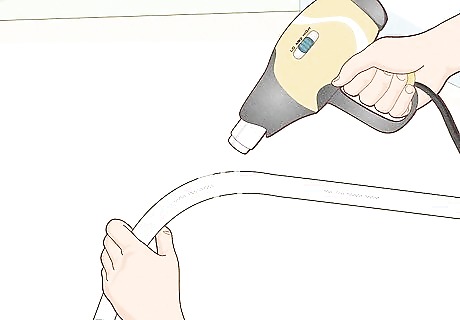
views
Can any kind of pipe be bent?

No, it depends on the material and size of the pipe. Softer materials, like copper and aluminum, are weak enough that you can often bend them by hand. Harder materials, like stainless steel or iron, are going to be exceptionally hard to bend without a pipe bender. The thickness of the pipe also plays into this—the thicker the pipe is, the harder it will be to bend. The softer the material is, the easier it will be to put softer U-shaped bends into the pipe. The harder the material is, the more likely you are to end up with a V-shaped bend.
How do you manually bend a pipe?

Fill the pipe with sand and heat it up. Load the interior of the pipe with dense sand and plug the openings with cloth. Then, set the pipe in a vice or on top of two sawhorses and grip the ends with large wrenches. Use a blow torch (for harder materials) or a hair dryer (for softer materials) and heat the area where you want to bend the pipe. Once the material gets extremely hot, put on heat-resistant gloves and bend the pipe by hand. Let it cool before emptying the sand and using your pipe. You need to wear the gloves even if you aren’t touching the area you heated directly. The entire pipe may get hot while you heat it. You can use the vice or wrenches to gain leverage if you need it. Some people find it easier to put some leather between your hands and the pipe to maintain your grip while you’re bending it. The sand will help the pipe keep its shape while you bend it. If you don’t fill the interior of the pipe, you’ll end up with kinks in the pipe.
How do you bend copper pipe without a pipe bender?

Use a bending spring to bend copper pipes by hand. Purchase a bending spring that matches the diameter of the pipe and stuff it inside of the pipe you want to bend. Then, bend the pipe slowly by hand. The bending spring will keep the pipe from kinking as you bend it. You may need to bend the pipe around the front of your knee to get a little bit of leverage if the pipe is thicker. You can also fill the pipe up with sand and plug the ends instead of using a pipe bender. You may need to use a hair dryer to heat the pipe up if it’s especially thick, but copper is weak enough that you can often bend it without heat. The longer and thinner your pipe is, the easier it will be to bend by hand. You can always use wrenches or a vice to get some extra leverage.
How do you bend metal tubing?

You need a tube bender. Pipes are used to transport liquids or air, but tubes are used structurally. This means that tubes are manufactured to be exceptionally strong. As a result, most tubes require unique tube bending equipment. The one exception here is copper tubing. You can actually bend this stuff by laying down a wood board and gently hitting the tube against an edge repeatedly. You may feel silly doing it, but the copper tubing will slowly bend with each impact.
How do you bend stainless steel without breaking it?

You have to use a pipe bender. There aren’t any reasonable DIY solutions not involving a pipe bender. The good news is that you probably aren’t going to break the stainless steel. Stainless steel is especially strong, and it actually becomes stronger the more you bend it.
How do you bend 2 in (5.1 cm) PVC pipe?

Fill the pipe with a drain auger and heat it up. Slide the auger all the way through the pipe and set it on a heat-resistant surface or saw horses. Turn a hair dryer on to high heat and blow hot air over the area of the pipe where you want it to bend. After a minute or two, put on heat-resistant gloves and bend the pipe slowly by hand. It may require several attempts to get it to bend the way you want. Once you’re done, slide the drain auger out and let the pipe cool. You can also fill the pipe with sand and plug the ends with cloth instead of using a drain auger. PVC is less prone to kinking than other materials though, so you should be fine with a drain auger. One of the advantages of PVC pipe is that it’s really easy to get around corners without bending. If you can, just get some joints, connectors, and PVC glue to connect multiple pieces to redirect your pipe around corners and edges. If you want to join two pipes, apply the pipe joint compound on the threads of the pipe. It is better to use a plumbing compound that contains Teflon. When Teflon gets wet, it expands and seals the leaks.
How do you bend PVC conduit without a bender?

Use a heat gun or blow dryer to bend the conduit. Set the blow dryer on high or start out with the heat gun on a medium setting. Slowly move the heat source back and forth along the section of conduit that you want to bend. Apply light pressure while you’re doing this so you can feel when the conduit is softened up. Once the conduit is malleable and easy to bend, pull it into whatever shape you’d like. Wear heat resistant gloves while you’re doing this. If you aren’t in a rush to finish the job, just buy factory-bent PVC conduit. Your work is going to look a lot cleaner if you don’t have to bend the conduit by hand.




















Comments
0 comment